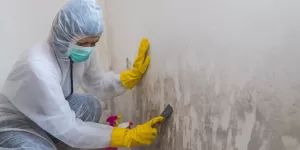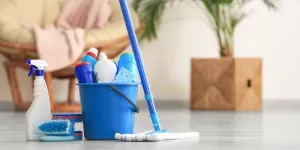Effects of Poor Indoor Air Quality on Children’s Health
"We may earn a commission for purchases made using our links. Please see our disclosure to learn more."
Effects of Poor Indoor Air Quality on Children’s Health: What Parents Need to Know
The effects of poor indoor air quality on children’s health are substantial. Because children have developing lungs and breathe more air relative to their body weight, they’re especially vulnerable to poor indoor air conditions. Polluted air can lead to respiratory issues, including asthma and chronic bronchitis. Furthermore, symptoms such as headaches, fatigue, and difficulty focusing can arise, possibly influencing their academic success.
While many studies highlight air quality in schools, it’s essential to remember kids spend much of their time at home. Routine activities like cooking, using cleaning agents, painting, or even applying cosmetics can introduce pollutants indoors.
A collaborative study between Universidad de Sevilla and Universidade de Lisboa shed light on bedrooms’ air quality. The results? Bedrooms often have the highest concentration of pollutants, making up a large portion of the air children breathe daily. It underscores why understanding the effects of poor indoor air quality on children’s health is vital for every parent.
What is Indoor Air Quality?
Indoor air quality (IAQ) refers to the quality of the air within buildings and structures, particularly in relation to the health and comfort of the occupants. It encompasses various factors such as the presence of pollutants, humidity levels, temperature, ventilation, and the overall cleanliness of the indoor environment.
Importance of Indoor Air Quality for Children’s Health
Children are more susceptible to the effects of poor indoor air quality due to their developing immune systems and higher respiratory rates. Exposure to indoor air pollutants can have significant impacts on their health and well-being.
Health Effects of Poor Indoor Air Quality on Children
- Respiratory Issues: Children exposed to indoor pollutants may experience respiratory problems such as asthma, allergies, bronchitis, or frequent coughing and wheezing.
- Decreased Lung Function: Prolonged exposure to poor indoor air quality can lead to reduced lung function in children, affecting their overall respiratory health.
- Increased Risk of Infections: Indoor air pollutants can make children more vulnerable to respiratory infections, increasing their likelihood of getting sick.
- Cognitive and Developmental Impacts: Studies have shown that poor indoor air quality can have negative effects on children’s cognitive development, including problems with attention, memory, and concentration.
Sources of Indoor Air Pollutants
- Tobacco Smoke: Secondhand smoke contains numerous toxins and carcinogens that can harm children’s respiratory health. It is crucial to have smoke-free environments to protect children from the harmful effects of tobacco smoke.
- Volatile Organic Compounds (VOCs): Cleaning products, paints, varnishes, and certain types of furniture can release VOCs into the air, contributing to poor indoor air quality.
- Mold and Dampness: Moisture problems in buildings can lead to the growth of mold and mildew, which can trigger allergic reactions and respiratory issues in children.
- Dust and Allergens: Dust mites, pet dander, pollen, and other allergens can accumulate indoors and worsen respiratory symptoms in children with allergies or asthma.
Improving Indoor Air Quality for Children’s Health
- Regular Cleaning: Maintain a clean indoor environment by regularly dusting, vacuuming, and mopping to reduce the presence of dust and allergens.
- Proper Ventilation: Ensure proper ventilation by opening windows when possible or using exhaust fans to bring in fresh air and remove stale air.
- Avoid Smoking Indoors: Create a smoke-free environment to protect children from the harmful effects of secondhand smoke.
- Control Humidity: Keep indoor humidity levels between 30% and 50% to prevent the growth of mold and mildew.
- Use Low VOC Products: Choose cleaning products, paints, and furniture that have low levels of VOCs to minimize the release of harmful chemicals into the air.
Remember, maintaining good indoor air quality is essential for promoting the health and well-being of children. By implementing these practices, you can create a healthier environment for them to thrive in.

Common Pollutants in Indoor Air
Indoor air quality plays a crucial role in maintaining the health and well-being of children. Unfortunately, many homes and buildings are riddled with various pollutants that can harm their delicate respiratory systems. Let’s take a closer look at some of the most common indoor air pollutants and their effects on children’s health.
Sources of Indoor Air Pollutants
Indoor air pollutants can originate from a variety of sources within our homes and buildings. Here are some common culprits:
- Tobacco Smoke: One of the primary sources of indoor air pollution, cigarette smoke contains harmful chemicals that can have serious health consequences for children.

- Volatile Organic Compounds (VOCs): These chemicals are released into the air from various household products such as paints, cleaning supplies, carpets, and furniture. VOCs can cause respiratory irritation and allergic reactions.

- Mold and Mildew: Moisture problems in buildings can lead to the growth of mold and mildew, releasing spores into the air. These spores can trigger allergies, asthma attacks, and other respiratory issues in children.

- Dust and Dust Mites: Dust and dust mites can accumulate in carpets, bedding, and upholstered furniture. Exposure to dust mite allergens can worsen symptoms for children with asthma or allergies.

- Pet Dander: Pets, such as cats and dogs, shed dander that contains allergens. These allergens can trigger respiratory symptoms in sensitive individuals, especially children with existing allergies or asthma.

Effects of Common Indoor Air Pollutants on Children’s Health
Now that we’ve identified some of the common indoor air pollutants, let’s explore their effects on children’s health:
- Respiratory Issues: Exposure to indoor air pollutants can lead to an increased risk of respiratory problems, such as asthma, bronchitis, and allergies. Children with developing respiratory systems are particularly vulnerable to these pollutants.
- Allergic Reactions: Many indoor pollutants, such as dust mites, mold spores, and pet dander, are known allergens that can trigger allergic reactions in children. These reactions may manifest as sneezing, itchy eyes, runny nose, and skin rashes.
- Reduced Lung Function: Prolonged exposure to certain indoor air pollutants, like tobacco smoke and VOCs, can hamper lung development in children. This can result in reduced lung function, making them more susceptible to respiratory infections and long-term respiratory issues.
- Cognitive and Developmental Impacts: Some studies suggest that exposure to indoor air pollutants, such as lead and environmental toxins, can negatively affect cognitive development and lead to behavioral problems in children.
It is crucial to be aware of these common indoor air pollutants and take steps to minimize their presence in our living environments. Regular cleaning, proper ventilation, and the use of air purifiers can help improve indoor air quality and protect the health of our children.
Remember, creating a healthy indoor environment for children starts with understanding and addressing the sources of indoor air pollution.
For more information, you can visit this website.
Health Issues Caused by Poor Indoor Air Quality
Indoor air quality plays a significant role in the health and well-being of individuals, particularly children who spend a substantial amount of time indoors. Poor indoor air quality can lead to various health issues, exacerbating respiratory problems, allergies, asthma, and even developmental issues. In this section, we will explore these health concerns in detail.
Respiratory Problems
One of the most common health issues associated with poor indoor air quality is respiratory problems. When indoor air is polluted, it can contain harmful gases, particulate matter, and irritants that can be inhaled and cause inflammation in the respiratory system. This can lead to respiratory symptoms such as coughing, wheezing, shortness of breath, and chest discomfort.
Children are particularly vulnerable to these respiratory issues due to their developing lungs and immune systems. Prolonged exposure to indoor air pollutants can increase the risk of respiratory infections, exacerbate existing respiratory conditions, and even hinder lung development.
To improve indoor air quality and reduce respiratory problems, it’s crucial to ensure proper ventilation, regular cleaning to remove dust and allergens, and minimizing the use of products that emit volatile organic compounds (VOCs), such as certain cleaning agents and air fresheners.
Allergies and Asthma
Poor indoor air quality can also trigger allergies and worsen asthma symptoms in children. Indoor environments can harbor allergens like dust mites, mold, pet dander, and cockroach allergens, which can cause allergic reactions when inhaled or come into contact with the skin.
Allergic reactions can manifest as sneezing, itching, watery eyes, runny nose, and skin rashes. For children with asthma, exposure to indoor allergens can trigger asthma attacks, leading to wheezing, coughing, chest tightness, and difficulty breathing.
Maintaining a clean and allergen-free indoor environment is crucial for reducing the risk of allergies and asthma. Regular cleaning, dusting, and vacuuming, as well as using allergen-proof covers on bedding, can help minimize exposure to common indoor allergens. Additionally, ensuring proper ventilation and keeping humidity levels in check can help prevent mold growth, which is a common asthma trigger.
Developmental Issues
In addition to respiratory problems and allergies, poor indoor air quality can also impact the development of children. Studies have suggested a correlation between exposure to indoor air pollutants and neurodevelopmental issues, including cognitive impairments, behavioral problems, and even lower IQ scores.
Certain indoor pollutants, such as lead, volatile organic compounds (VOCs), and environmental tobacco smoke, can have neurotoxic effects on the developing brain. These substances can enter the bloodstream and affect the central nervous system, potentially leading to long-term cognitive and behavioral consequences.
To safeguard children’s development, it’s essential to minimize their exposure to these harmful substances. This can be achieved by avoiding smoking indoors, using lead-safe paint and products, and ensuring proper ventilation to reduce the concentration of pollutants.
Remember, maintaining good indoor air quality is crucial for the overall health and well-being of children. By understanding and addressing the health issues caused by poor indoor air quality, we can create safer and healthier environments for our little ones to thrive.

Long-Term Effects of Poor Indoor Air Quality on Children
Indoor air quality plays a crucial role in the overall health and well-being of children. Prolonged exposure to poor indoor air quality can have significant long-term effects on their health. In this section, we will explore the impact of poor indoor air quality on children’s cognitive development and the increased risk of chronic diseases they face.
Impact on Cognitive Development

Poor indoor air quality can negatively impact a child’s cognitive development. Studies have shown that exposure to air pollutants, such as volatile organic compounds (VOCs) and particulate matter, can impair cognitive function in children. These harmful substances can be found in various household products, including cleaning agents, paints, carpets, and furniture.
Research has indicated that children exposed to high levels of indoor air pollutants may experience difficulties in concentration, memory, and learning abilities. The developing brain is more vulnerable to the toxic effects of air pollutants, which can hinder the growth and proper functioning of neural networks. This impairment in cognitive development can have long-lasting consequences for a child’s academic performance and overall intellectual abilities.
Increased Risk of Chronic Diseases
Poor indoor air quality is also closely linked to an increased risk of chronic diseases in children. Exposure to indoor air pollutants, such as tobacco smoke, mold spores, pet dander, and allergens, can trigger or exacerbate respiratory conditions like asthma and allergies.
Children with asthma are particularly susceptible to the adverse effects of indoor air pollution. The presence of airborne irritants and allergens can trigger asthma attacks, causing wheezing, coughing, shortness of breath, and chest tightness. Long-term exposure to poor indoor air quality can lead to the development and worsening of respiratory conditions, making it harder for children to manage their symptoms and enjoy a good quality of life.
Furthermore, poor indoor air quality has been associated with an increased risk of respiratory infections in children. Airborne pathogens and pollutants can compromise their immune system and make them more susceptible to infections such as colds, flu, and bronchitis. These infections can further contribute to the progression of chronic respiratory diseases and hinder children’s overall respiratory health.
It is essential for parents and caregivers to prioritize improving indoor air quality to safeguard children’s health and well-being. This can be achieved through proper ventilation, regular cleaning and maintenance, minimizing exposure to pollutants, and utilizing air purifiers or filtration systems.
By ensuring a clean and healthy indoor environment, we can mitigate the long-term effects of poor air quality on children and promote their overall development and well-being.
Please note that it is always advisable to consult with healthcare professionals for personalized advice and guidance regarding children’s health concerns related to indoor air quality.
References:
- Effects of Indoor Air Pollution on Cognitive Function in Children
- Indoor Air Pollution and the Risks to Children
- Impact of Indoor Air Pollution on Children’s Respiratory Health
Strategies for Improving Indoor Air Quality
One of the most important aspects of maintaining a healthy environment for children is ensuring good indoor air quality. Poor air quality in indoor spaces can have detrimental effects on children’s health, ranging from respiratory issues to allergies and even long-term health problems. By implementing the following strategies, you can significantly improve the indoor air quality in your home or any other space where children spend time.
Proper Ventilation

Proper ventilation is crucial for improving indoor air quality. It helps remove stale air and pollutants while bringing in fresh outdoor air. Opening windows and doors whenever possible allows for natural ventilation, which helps reduce the concentration of harmful pollutants. Additionally, installing and using exhaust fans in kitchens and bathrooms helps remove moisture, odors, and pollutants generated from cooking or cleaning activities.
Regular Cleaning and Maintenance

Regular cleaning and maintenance play a vital role in ensuring good indoor air quality. Dust, dirt, and other particles can accumulate on surfaces and become airborne, contributing to indoor air pollution. By regularly dusting surfaces, vacuuming carpets and rugs, and mopping floors, you can reduce the amount of dust and allergens in the air. It is also important to clean or replace air filters regularly to ensure efficient air circulation and filtration.
Use of Air Purifiers and Filters

Air purifiers and filters are effective tools for removing pollutants from the air, especially in spaces where natural ventilation is limited. High-quality air purifiers can help filter out allergens, dust, pet dander, and other harmful particles, providing cleaner air for children to breathe. Additionally, using HEPA (High-Efficiency Particulate Air) filters in central HVAC systems can further improve indoor air quality by trapping microscopic pollutants.
Incorporating these strategies into your indoor environment can go a long way in improving the air quality that children are exposed to. By promoting proper ventilation, practicing regular cleaning and maintenance, and utilizing air purifiers and filters, you create a healthier and safer space for children to thrive and grow.
Remember, when it comes to children’s health, ensuring good indoor air quality should be a top priority. By taking these steps, you can provide them with a cleaner and healthier environment, reducing the risk of respiratory issues and other health problems associated with poor air quality.
For more information on the effects of poor indoor air quality on children’s health, you can visit HealthyChildren.org or EPA’s Indoor Air Quality website.
Keep in mind that maintaining a clean and healthy indoor environment is an ongoing effort, and these strategies should be implemented consistently to ensure optimal results.
Importance of Early Detection and Prevention
Indoor air quality plays a crucial role in the overall health and well-being of children, as they spend a significant amount of time indoors. It is essential to prioritize early detection and prevention of poor indoor air quality to safeguard their health. This section will discuss two vital aspects of addressing this issue: regular check-ups and monitoring, and educating parents and caregivers.
Regular Check-ups and Monitoring
Regular check-ups and monitoring are essential to identify and assess the effects of poor indoor air quality on children’s health. By visiting healthcare professionals regularly, parents can ensure that any potential health issues related to the indoor environment are promptly recognized and addressed.
During these check-ups, healthcare providers can evaluate children’s symptoms and conduct appropriate tests to determine if there is a link between their health concerns and the indoor environment. Additionally, regular monitoring of air quality within the home can help identify potential contaminants or pollutants that may be affecting a child’s health.
 Woman in White Lab Coat Listening to a Girl and Writing Down Notes (Photo by Pavel Danilyuk)
Woman in White Lab Coat Listening to a Girl and Writing Down Notes (Photo by Pavel Danilyuk)
By staying proactive and vigilant in scheduling check-ups and monitoring indoor air quality, parents can take early action to mitigate any risks and provide a safer living environment for their children.
Educating Parents and Caregivers
Educating parents and caregivers is crucial in creating awareness about the impact of poor indoor air quality on children’s health. By increasing knowledge and understanding, parents can take appropriate measures to prevent and minimize exposure to indoor pollutants.
Providing resources and information about common indoor pollutants, such as allergens, mold, volatile organic compounds (VOCs), and tobacco smoke, can empower parents to make informed decisions about their children’s environment. This education should include guidance on identifying potential signs and symptoms of poor indoor air quality, as well as steps to improve air quality at home.
 Woman Reading a Story to Her Child (Photo by Andrea Piacquadio)
Woman Reading a Story to Her Child (Photo by Andrea Piacquadio)
By promoting awareness and knowledge-sharing, parents and caregivers can play an active role in creating a healthier indoor environment for children. This can involve implementing proper ventilation systems, using air purifiers, maintaining cleanliness, and adopting healthy habits, such as smoke-free homes.
Link: American Lung Association – Indoor Air Quality
In conclusion, early detection and prevention are vital in addressing the effects of poor indoor air quality on children’s health. Regular check-ups and monitoring alongside educating parents and caregivers can help identify potential risks and take appropriate actions to safeguard children’s well-being. By prioritizing these aspects, we can create healthier indoor environments for our children, ensuring their long-term health and happiness.
Conclusion
In conclusion, poor indoor air quality can have significant effects on children’s health. Children are particularly vulnerable to the negative impacts of indoor air pollutants due to their developing respiratory systems and higher air volume intake per body weight. Exposure to these pollutants can increase the risk of respiratory illnesses such as chronic bronchitis and asthma in young children. It can also lead to symptoms such as headaches, drowsiness, and difficulties in concentration, which can impact their performance at school.
While previous research has mainly focused on indoor air quality in schools, it is important to recognize that children spend the majority of their time at home. Therefore, it is crucial to address indoor pollutants in residential environments as well. Research conducted by the Universidad de Sevilla and Universidade de Lisboa highlighted that homes are responsible for a significant portion (88 percent) of indoor air pollutants. Among the different microenvironments in homes, bedrooms were found to have the highest exposure and inhalation of air pollution, accounting for a substantial portion (56 to 64 percent) of the daily inhaled dose of measured compounds.
To mitigate the risks associated with poor indoor air quality, it is essential to implement guidelines and regulations that target the reduction of indoor air pollutants. Adequate ventilation systems should be incorporated into housing stock to improve air circulation and quality. Additionally, regulating products and materials through labeling or higher standards can help control indoor pollutants. By prioritizing the improvement of indoor air quality, we can create healthier and safer environments for our children, minimizing the negative impact on their health and well-being.



